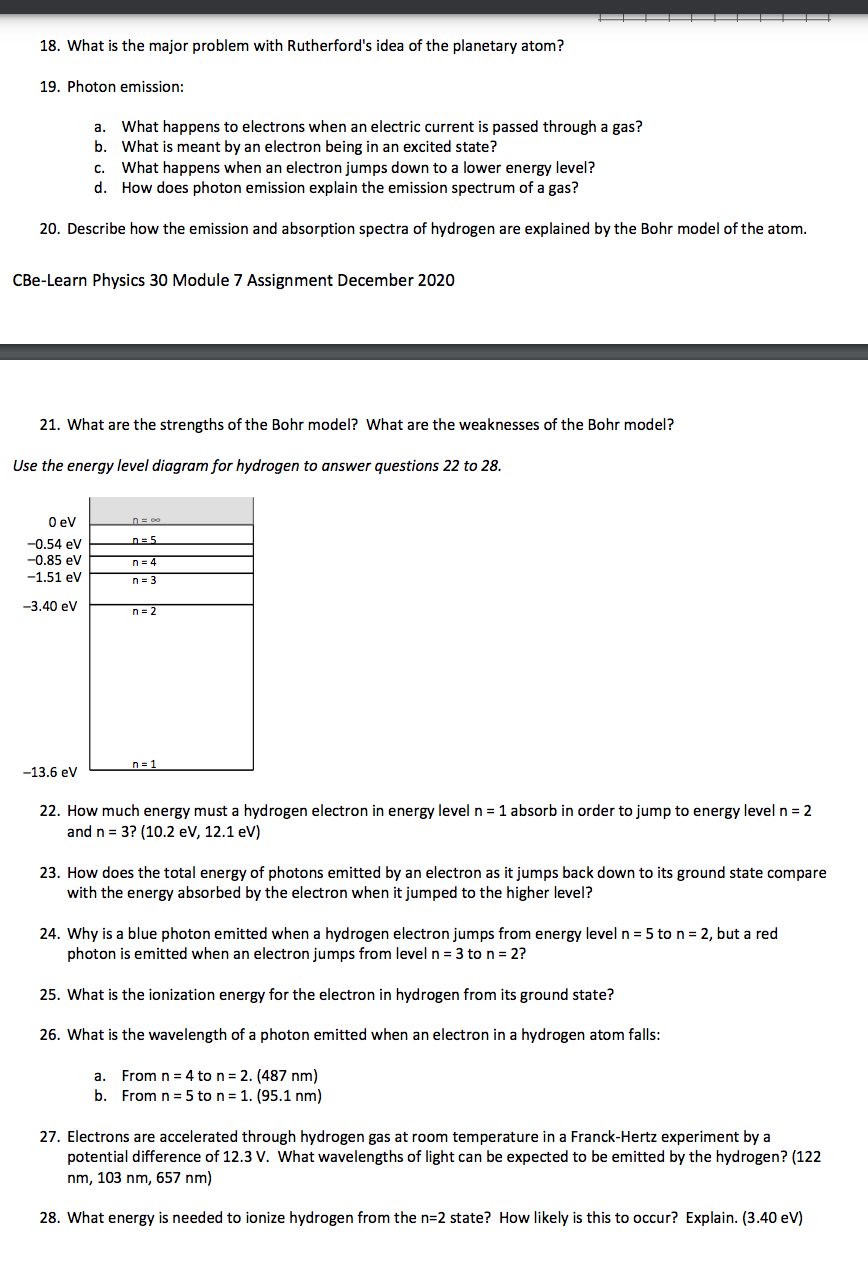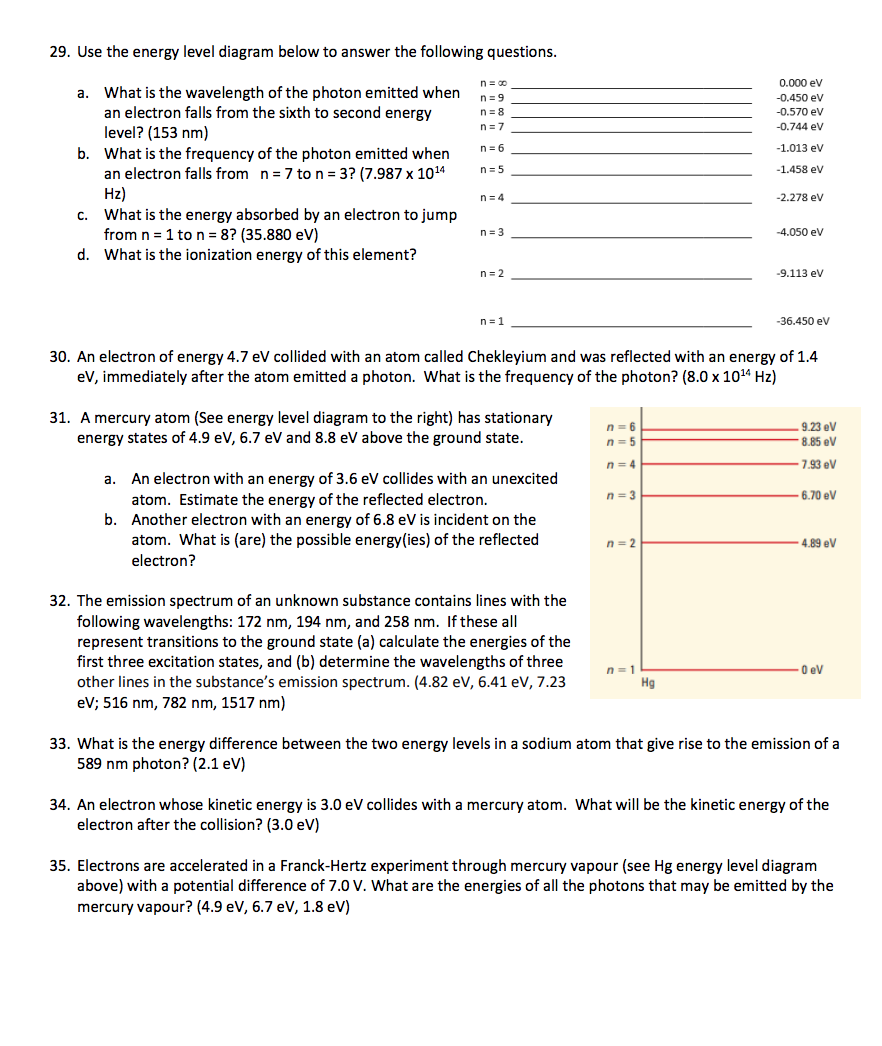Question
18. What is the major problem with Rutherford's idea of the planetary atom? 19. Photon emission: a. What happens to electrons when an electric


18. What is the major problem with Rutherford's idea of the planetary atom? 19. Photon emission: a. What happens to electrons when an electric current is passed through a gas? b. What is meant by an electron being in an excited state? c. What happens when an electron jumps down to a lower energy level? d. How does photon emission explain the emission spectrum of a gas? 20. Describe how the emission and absorption spectra of hydrogen are explained by the Bohr model of the atom. CBe-Learn Physics 30 Module 7 Assignment December 2020 21. What are the strengths of the Bohr model? What are the weaknesses of the Bohr model? Use the energy level diagram for hydrogen to answer questions 22 to 28. 0 eV n=00 -0.54 eV n=5 -0.85 eV n = 4 -1.51 eV n = 3 -3.40 eV n = 2 n=1 -13.6 eV 22. How much energy must a hydrogen electron in energy level n = 1 absorb in order to jump to energy level n = 2 and n = 3? (10.2 eV, 12.1 eV) 23. How does the total energy of photons emitted by an electron as it jumps back down to its ground state compare with the energy absorbed by the electron when it jumped to the higher level? 24. Why is a blue photon emitted when a hydrogen electron jumps from energy level n = 5 to n = 2, but a red photon is emitted when an electron jumps from level n = 3 to n = 2? 25. What is the ionization energy for the electron in hydrogen from its ground state? 26. What is the wavelength of a photon emitted when an electron in a hydrogen atom falls: a. From n = 4 to n = 2. (487 nm) b. From n = 5 to n = 1. (95.1 nm) 27. Electrons are accelerated through hydrogen gas at room temperature in a Franck-Hertz experiment by a potential difference of 12.3 V. What wavelengths of light can be expected to be emitted by the hydrogen? (122 nm, 103 nm, 657 nm) 28. What energy is needed to ionize hydrogen from the n=2 state? How likely is this to occur? Explain. (3.40 eV) 29. Use the energy level diagram below to answer the following questions. a. What is the wavelength of the photon emitted when an electron falls from the sixth to second energy level? (153 nm) 0.000 ev -0.450 eV n co n=9 n=8 -0.570 eV n=7 -0.744 eV b. What is the frequency of the photon emitted when an electron falls from n = 7 to n = 3? (7.987 x 104 Hz) n=6 -1.013 eV n=5 -1.458 eV n=4 -2.278 eV c. What is the energy absorbed by an electron to jump from n = 1 to n = 8? (35.880 eV) n = 3 -4.050 eV d. What is the ionization energy of this element? n = 2 -9.113 eV n = 1 -36.450 eV 30. An electron of energy 4.7 eV collided with an atom called Chekleyium and was reflected with an energy of 1.4 eV, immediately after the atom emitted a photon. What is the frequency of the photon? (8.0 x 1014 Hz) 31. A mercury atom (See energy level diagram to the right) has stationary energy states of 4.9 eV, 6.7 eV and 8.8 eV above the ground state. n=6 9.23 eV n=5 n=4 8.85 eV -7.93 eV a. An electron with an energy of 3.6 eV collides with an unexcited atom. Estimate the energy of the reflected electron. n=3 6.70 eV b. Another electron with an energy of 6.8 eV is incident on the atom. What is (are) the possible energy(ies) of the reflected electron? 32. The emission spectrum of an unknown substance contains lines with the following wavelengths: 172 nm, 194 nm, and 258 nm. If these all represent transitions to the ground state (a) calculate the energies of the first three excitation states, and (b) determine the wavelengths of three other lines in the substance's emission spectrum. (4.82 eV, 6.41 eV, 7.23 eV; 516 nm, 782 nm, 1517 nm) n = 2 4.89 eV n=1 Hg 0 eV 33. What is the energy difference between the two energy levels in a sodium atom that give rise to the emission of a 589 nm photon? (2.1 eV) 34. An electron whose kinetic energy is 3.0 eV collides with a mercury atom. What will be the kinetic energy of the electron after the collision? (3.0 eV) 35. Electrons are accelerated in a Franck-Hertz experiment through mercury vapour (see Hg energy level diagram above) with a potential difference of 7.0 V. What are the energies of all the photons that may be emitted by the mercury vapour? (4.9 eV, 6.7 eV, 1.8 eV)
Step by Step Solution
There are 3 Steps involved in it
Step: 1

Get Instant Access with AI-Powered Solutions
See step-by-step solutions with expert insights and AI powered tools for academic success
Step: 2

Step: 3

Ace Your Homework with AI
Get the answers you need in no time with our AI-driven, step-by-step assistance
Get Started


